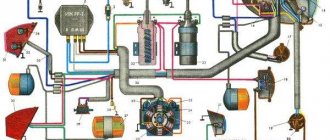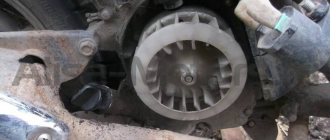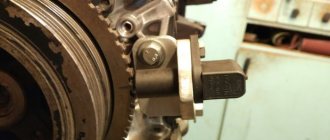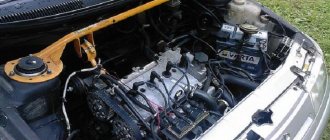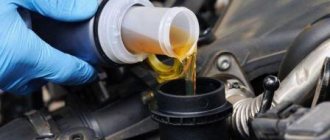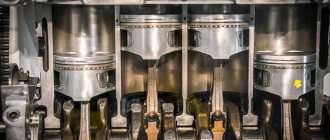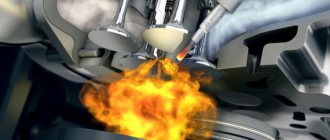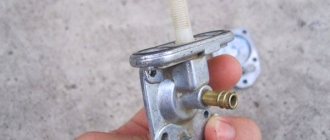The correct operation of the power unit of a modern car is influenced by numerous parts and systems. And if something starts to work incorrectly, this will lead to failure of engine parts and the engine itself. One of the serious problems for the engine is its detonation and continued operation after the ignition is turned off. This malfunction confuses many car enthusiasts who are unable to understand its cause. And it arises due to the so-called glow ignition, as a result of which the car does not immediately stall after stopping the engine. This article will help you understand why this happens.
Features of the glow ignition effect
Glow ignition on a running engine occurs uncontrollably, before or after sparking, igniting the fuel charge unevenly. It is worth noting that the speed of flame front propagation during glow ignition is similar to the normal speed resulting from spark ignition. Thanks to this, the fuel burns and does not explode. This combustion is the fundamental difference between short circuit and detonation.
It must be added that glow ignition is no less harmful to the internal combustion engine compared to the detonation combustion process, and can cause serious damage to the engine and significantly reduce its service life.
It is more difficult to diagnose glow ignition compared to detonation and other knocks on a running engine, since no obvious knocks are heard. The main symptom is loss of power under load, increased fuel consumption, overheating, and muffled knocking. It is easier to determine a short circuit if the engine continues to run after the ignition is turned off. This indicates spontaneous ignition of fuel from contact with highly heated parts and surfaces. To eliminate the causes of such a malfunction, you must:
- use high-quality fuel;
- check the proper operation of the internal combustion engine cooling system;
- eliminate possible engine detonation, causing severe overheating;
- remove carbon deposits and deposits in the combustion chamber;
- install candles that have the recommended heat rating;
- make sure that the systems that stop the fuel supply after the ignition is turned off are in good working order;
Third reason: incorrectly selected candles
Spark plugs have different properties of a ceramic insulating coating that helps dissipate heat. Incorrectly selected spark plugs become very hot, and the power unit does not stall immediately. They have their own heating value and are divided into cold and hot types. You can distinguish a cold type from a hot one by the appearance of the insulating coating. A short size ceramic insulator indicates a cold plug, and a long size indicates a hot type.
Different power units have different requirements for the type of spark plugs, which are determined by the design of the cylinder head and its cooling system. This is precisely why different glow numbers of candles are provided. When replacing them, especially independently, few drivers pay due attention to this. Having installed inappropriate spark plugs, you should not be surprised why the unit does not stall immediately.
Spark plugs are one of the main reasons for this negative effect in a car. The use of spark plugs with an extended insulator (hot type) in the engine helps to retain heat from the heating of the running engine. This may well contribute to the appearance of glow ignition, which ignites the remaining combustible mixture in the combustion chamber, as a result of which the engine simply does not stall.
Few car owners know about the factory thermal characteristics of the installed power unit. They may mistakenly use cold spark plugs that are not intended for this model, in which case the opposite effect occurs when the car starts poorly or periodically stalls at high speeds. You should pay very close attention to the manufacturer’s recommendations, even in such seemingly unimportant information about the installed spark plugs.
Course of depression
Like the Great Depression of the 20th century, the Long Depression occurred in different countries at different times and with different intensities, and some countries experienced isolated periods of rapid economic growth. However, in general, 1870-1890. were a time of falling price levels, and economic growth rates remained significantly lower than in the periods before and after the depression.
Between 1870 and 1890, iron production in the five leading producing countries more than doubled, from 11 to 23 million tons, steel production increased more than 20 times (from 0.5 million to 11 million tons), and the construction of railways was most intensive. At the same time, prices in some markets fell significantly - the price of grain in 1894 was only a third of the price in 1867, and the price of cotton fell by almost 50% in just five years (from 1872 to 1877), leading to the emergence of significant financial difficulties for agricultural workers. The sharp decline in prices forced a number of countries, such as France, Germany and the United States, to resort to protectionist measures, and caused mass emigration from other countries such as Italy, Spain, Austria-Hungary and Russia. Likewise, while production volume
iron between 1870 and 1890
doubled, the price of
iron fell by 2 times.
In many countries, economic growth rates were significantly lower than both after and before the Depression:
Industrial Production Growth Rates (1850s to 1913)
| 1850s-1873 | 1873—1890 | 1890—1913 |
| 4.3 | 2.9 | 4.1 |
| 3.0 | 1.7 | 2.0 |
| 6.2 | 4.7 | 5.3 |
| 1.7 | 1.3 | 2.5 |
| 0.9 | 3.0 | |
| 3.1 | 3.5 |
GNP of the great powers of Europe (billions of US dollars, 1960 prices)
| 1830 | 1840 | 1850 | 1860 | 1870 | 1880 | 1890 |
| 10.5 | 11.2 | 12.7 | 14.4 | 22.9 | 23.2 | 21.1 |
| 8.5 | 10.3 | 11.8 | 13.3 | 16.8 | 17.3 | 19.7 |
| 8.2 | 10.4 | 12.5 | 16.0 | 19.6 | 23.5 | 29.4 |
| 7.2 | 8.3 | 10.3 | 12.7 | 16.6 | 19.9 | 26.4 |
| 7.2 | 8.3 | 9.1 | 9.9 | 11.3 | 12.2 | 15.3 |
| 5.5 | 5.9 | 6.6 | 7.4 | 8.2 | 8.7 | 9.4 |
Austria-Hungary
The first manifestation of the global crisis was the stock market crash on the Vienna Stock Exchange in May 1873. In Hungary, the Panic of 1873 led to the end of excessive railway construction.
France
France's position during the crisis was unique: the country was already in dire straits before 1873 due to the payment of reparations to Germany in the amount of 200 million pounds sterling after defeat in the Franco-Prussian War. During the period of reparations, the French government deliberately pursued a policy of deflation.
While economic growth briefly resumed in the United States in the 1880s, the Paris Stock Exchange crash of 1882 ushered in a depression that "lasted longer and cost France more than any other depression of the 19th century." In the same 1882, the French bank Union Générale went bankrupt, which caused a collapse in the quotations of French securities and led to the withdrawal of three million pounds sterling from the Bank of England by the French.
The financial crisis in France was aggravated by epidemics that affected winemaking and the silk industry. Capital formation and foreign investment were at their lowest levels in the last half of the 19th century. Although new investment banks developed rapidly after the end of the Franco-Prussian War, the crisis stopped the development of the banking industry, which only recovered at the beginning of the 20th century. An additional blow to the financial sector was dealt by unsuccessful investments abroad, mainly in railways. France's net national product declined for 10 years from 1882 to 1892.
Italy
After 1887, a ten-year customs war began between France and Italy, complicating Franco-Italian relations, which flourished during the unification of Italy. Since France was the largest foreign investor, the Italian economy was particularly hard hit by the liquidation of French assets.
Russia
In Russia, as in the United States, the Long Depression manifested itself as three separate recessions (1874–1877, 1881–1886, and 1891–1892), which largely affected manufacturing, with the economy recovering in between.
Great Britain
Although in Great Britain since the 1820s. financial crises occurred every decade. The Long Depression did not have a significant negative impact on the country's economy, despite the fact that the Bank of England in the 1870s. kept the interest rate high - up to 9 percent. In 1879, due to the reform of the Irish Land Act of 1870, the Irish famine of 1879, falling agricultural prices and high rents, thousands of Irish farmers tenants began to fight for land (English Land War) Land War, as a result of which the reform of the Irish Land Acts (English Irish Land Acts) was carried out.
USA
Real gross national product per capita in the United States, 1869–1918. Estimation of the decline in production volumes in selected US industries (1872-1876).
| Industry | Decrease in production volume, % |
| Durable goods | 30 % |
| Ferrous metallurgy | 45 % |
| Construction | 30 % |
| All in all | 10 % |
In the United States, the Long Depression began with the Panic of 1873. According to the National Bureau of Economic Research, the decline in economic activity that followed the panic lasted from October 1873 to March 1879. This is the longest period of recession recorded by the Bureau - 65 months; The duration of the decline in economic activity during the Great Depression was 43 months. Data reported by Milton Friedman and Anna Schwartz show that net national product (NNP) grew by 3 percent annually from 1869 to 1879, and that real national product grew by 6 percent annually during this period. 8% per year. However, because the US population grew by more than 17.5% between 1869 and 1879, the growth in NNP per capita was less. The economic situation in the United States would remain unstable: from 1879 to January 1901, there was a recession in 114 of 253 months.
The sharp change in prices had an extremely adverse effect on the size of nominal wages: in the 1870s. nominal wages in the United States fell by a quarter, and in some states, such as Pennsylvania, nominal wages fell by half. Although real wages rose at a steady rate in the post-Civil War period (almost a quarter between 1865 and 1873), they remained stagnant until the 1880s; steady growth in real wages resumed in the late 1880s. The sharp drop in cotton prices dealt a heavy blow to the economy of the US South, devastated by the Civil War. However, despite a significant drop in prices for agricultural products, production in this industry continued to grow.
Thousands of American companies went bankrupt, with unfulfilled obligations amounting to more than a billion dollars. In New York in the winter of 1873-1874, one in four workers was unemployed, and throughout the country the number of unemployed people was about a million.
The manufacturing, construction and railway industries suffered the most significant declines in production. Before the crisis, the railway industry was one of the key sectors ensuring the growth of the US economy - for 1867-1873. the length of railway lines increased by 50%, and the amount of capital investment in this industry amounted to 20% of total investment in the United States. In 1873, the development of the industry stopped abruptly: between 1873 and 1878, the increase in the length of railway lines was minimal.
Freedman's Savings Bank, established in 1865 to improve the economic well-being of post-Civil War slaves, is a typical example of a company that fell victim to the financial crisis. In the early 1870s. The bank's management decided to engage in market speculation and invested in real estate and unsecured loans from railroad companies. The bank's failure in 1874 dealt a serious blow to the financial position of African American investors.
The recession also dealt a heavy blow to the political reputation of US President Ulysses S. Grant. Here's what historian Allan Nevins writes about the end of his presidency:
The economy began to recover in 1878. The length of laid railway tracks increased from 4,289 km in 1878 to 18,619 km in 1882. The construction industry began to recover in 1879: the cost of building permits increased 2.5 times between 1878 and 1883; at the same time, unemployment fell to 2.5%, despite high immigration.
However, the economic recovery did not last long. The profit margin of enterprises fell sharply between 1882 and 1884, in the railway industry the period of recovery also gave way to a decline in indicators: if in 1882 18,619 km of tracks were laid, then in 1885 - only 4,612 km, and the price of steel rails fell from 71 dollar per ton in 1880 to 20 dollars per ton in 1884. The manufacturing industry was also affected - the production of durable consumer goods again fell by a quarter. The recession developed into a financial crisis when in 1883-1884. foreign investors, fearing that the US government would abandon the gold standard, got rid of tens of millions of dollars worth of American securities, after which many New York banks went bankrupt in 1884. The financial panic led to the failure of eleven New York banks, hundreds of state bank failures, and at least $32 million in defaults. Unemployment, which had been at 2.5% between recessions, rose sharply to 7.5% in 1884–1885, and in the Northeastern states to 13%. At the same time, in response to the worsening labor market situation, the influx of immigrants has decreased significantly.
A second wave of recession caused agricultural prices to fall further: In 1885, Kansas farmers used their corn crops for fuel as the price fell below the prices of coal and lumber. A new stage of economic recovery began in 1885.
Dieseling and glow ignition
Both short circuit and dieseling are similar to each other - as in the first and second cases, the engine does not stall immediately after turning off the ignition.
However, diesel engine dieseling differs from short circuit and can occur as a result of:
- With an increased engine compression ratio;
- When using low octane fuel.
Glow ignition - the air-fuel system continues to operate independently, which is caused by contact with glow plugs or other hot elements of the fuel system. Dieseling is also the spontaneous ignition of gasoline. But in this case, the operation of the engine after it is completely turned off and the keys are removed from the ignition is affected by the compression level, and only after that by the hot surfaces.
Note that compared to detonation, glow ignition causes less harm. But, as mentioned above, it can ignite in inappropriate places, which leads to melting of the spark plugs, overheating of the pistons, and so on.
If the “heart” of the car works “unevenly” after turning off the ignition, then this is definitely not a glow ignition. Short circuit has one feature - the motor in any case works without jerking.
In the case of diesel engine, the engine will jerk strongly and run unevenly.
It is worth saying that dieseling is a problem that is more common in cars that have engines with a high compression level. This problem can also occur if the cooling system is faulty.
It is also worth adding that most modern engines operate on the principle: turning off the ignition means completely cutting off the fuel supply. If the new vehicle “twitches” after being completely turned off, then there is a possibility of problems arising in its certain power points. Another possible cause is a breakdown of the blocking systems.
Injection engine
Now let's look at another option with an injection engine. If detonation occurs after shutting down, it means the injectors are not holding fuel. Despite the fact that electrical impulses are not supplied to the injectors, the fuel rail is under pressure. If the injectors are not tight enough, the valves are worn out, then fuel still passes through.
An air-fuel mixture is formed and enters the cylinders. The engine makes a few more revolutions and detonates. Here's the main reason. If the engine is working properly, it should stall immediately.
This applies to gasoline engines, we are not talking about diesel engines here. Single injection has the same problem. If one mono injector is leaking, fuel enters the intake manifold, a combustible mixture is formed, which enters the cylinders, and the engine detonates (hums) for some time.
RooTC 10 Aug 2012 10:04
Guys, what if we proceed from the principle of operation of a vacuum seal? What is its main failure - membrane rupture. You can remove the hose from the opposite end from the vacuum valve and bluntly suck or blow in air with your lips. The integrity of the membrane will be felt immediately, or if it is leaky, the air will siphon.
Now this is more interesting. The question is how effective is it?
Is this what is called glow ignition, not diesel spark plugs? In theory, when the engine is stopped, the carb should automatically go to the starting position, while the remote control may be slightly open. Glow ignition occurs due to self-ignition of the mixture from hot cylinder parts, in particular spark plug electrodes
hmm, I’ve been using these spark plugs for a long time, about 40 thousand. 3-pin, which ones exactly - I don’t know. Unfortunately, I don’t know what it’s called correctly, you turn it off, and the engine still shudders a couple of times. Yesterday it practically started up like that.
The machine works after switching off...
What is the reason? Buy a 93 year old Nissan Laurel. When you turn off the engine, the car continues to run for another 5-10 seconds... The technicians said that the alarm system is “buggy” - did they check everything is working properly???
There may be a turbo timer on the alarm. On the key fob, if it has a screen, the word turbo should be displayed. This interval can be adjusted from 10 seconds to 2 minutes. To stop and cool the turbine. This is if it is there (signaling with a timer and a turbine). And if one or the other is not there, it’s a computer glitch.
Presage VNU30 YD25 140000km
Or maybe these are the consequences of glow ignition?
was VAZ 21099 1995 (1.5 carburetor) became Nissan Sunny 1990 (GA16DE after capital) will be
Posted by
Jura55ickOr maybe these are the consequences of glow ignition?
Hardly. Fire ignition (detonation) looks like the engine “jerking” after turning the key. If the engine runs smoothly for these 5-10 seconds, there will definitely be electronic interference.
Nissan Sunny Wagon Y10 2.0 dSLx
It’s quite easy to distinguish between this signal and something else (especially on a ’93 car); before turning off the ignition, turn on the climate control/radio or something else that only works when the ignition is on. Pull out the key, if something continues to work then it means that something in your car actually did not turn off the ignition. This is something 100% signaling and not a fact that it is a malfunction. For example, my alarm (I don’t know which one) does not turn off the ignition for another minute after I pull out the key, I turn it off either with the key fob or by turning the key again in the ignition - this is its standard feature.
If this is an alarm, then turn off the car with the brake pressed by default on all alarms; pressing the brake turns off the turbo timer when you remove the key from the lock
Posted by
danil200If this is an alarm, then turn off the car with the brake pressed by default on all alarms; pressing the brake turns off the turbo timer when you remove the key from the lock
Well, if there is a turbo timer, for example, I don’t have one, and the minute delay in turning off the ignition was made not to allow the turbine to stop (and I don’t have a turbo), but so that I could (if I want) arm the car without turning it off the engine, and this garbage is turned off not by the brake, but by turning the key again... In short, Author, read the manual for the signaling.
The signal light is simple, it's a Challenger 8000i, it doesn't even have a trigger, by the way, when you turn the key to zero, all the electrical equipment of the car goes out. But I'm not sure about the smoothness of the engine, it stalls as if it's running out of gas.
Message from
KOSTYABRATSKThe signal light is simple, it's a Challenger 8000i, it doesn't even have a trigger, by the way, when you turn the key to zero, all the electrical equipment of the car goes out. But I'm not sure about the smoothness of the engine, it stalls as if it's running out of gas.
Well, this looks like glow ignition. When this happened to me, after turning the key the car started to shake, like it was tripping or even double - in principle, that’s how it is. Try accelerating before you turn it off. Will it get better or not? And this…. What kind of gasoline is in it? Over-ignition is one of the consequences of low-octane gasoline. Like, instead of 92, 76 is filled in.
Nissan Sunny Wagon Y10 2.0 dSLx
The spark plugs are not in place, when they get too hot they give a spark, when you unscrew them they will have a red rim. Replace the spark plugs and everything will go away
It's not the signaling system that's faulty, look at the engine.
Thank you all so much!!!!!!!!!!!!I’ll look into it!
Brothers, I want to raise the topic again!!! I tried everything, the result was zero! The topic of glow ignition also disappeared. The essence of the test is the following: at the same time the ignition is turned off and the wire is removed from the coil (rb20-e) - the car immediately stalled. The diagnostics show 5-5. By the way, in the fuel supply system, as I understood from the explanation, the return valve does not hold( It seems like this) could this be the reason? Maybe there is a relay that compensates the brains, because it turns out there is a voltage in the coil?????????
Fighting carbon deposits
Necessary materials:
- fuel additives for engine cleaning;
- high quality fuel.
Step 1: Try Engine Cleaning Supplements
If you have tried all of the above steps and still do not get rid of the problem and the engine does not stall right away, then you probably have severe carbon deposits in your engine.
Carbon deposits can cause an increase in engine compression and create particularly hot spots in the engine's combustion chamber, which can subsequently lead to diesel burn. There are now many different additives on the market designed to clean the engine while it is running.
Following the manufacturer's instructions, mix the additive with the fuel when refueling your vehicle. Then you need to get onto the highway and drive some distance at high speed, while accelerating strongly several times. A fuel cleaning formula can help break down carbon deposits and remove them through the exhaust pipe.
When discussing your problem, you will most likely encounter an experienced technician who will advise you to pour a glass of water into the carburetor while the engine is running. Politely thank the expert, but under no circumstances follow this advice. This is just a good way to damage your engine.
Step 2: Change fuel
Using higher octane fuel can help mitigate the "diesel" problem that you haven't been able to get rid of using other methods. You must understand that this is not a way to get rid of the problem, but a form of proper engine care.
High-octane fuel is more stable and less susceptible to premature ignition from hot carbon deposits in the engine.
Over time, it will become clear to you that refueling with more expensive fuel is too expensive. In addition, the initial impressive effect of using high-octane fuel will diminish over time. To finally solve the problem, a more thorough engine repair may be required.
How to detect a malfunction?
For owners of cars with smart hardware, the task of detecting a problem is greatly simplified. The electronics generate error codes indicating a faulty cylinder.
Cars with and without an ECU need to be checked differently.
Car with ECU
We connect the scanner and start deciphering the error codes
If the code contains an indication of a specific cylinder, you need to pay attention to it first. The problem may be in the spark plugs or in the wiring connected to this cylinder
It's worth checking the gaskets. If error P0300 appears, check the fuel filter and the quality of the fuel mixture used. The reading on the P0204 device indicates damage to the injector.
Many cars, even those made in Russia, are now equipped with electronic units. If the ECU does not work correctly, it is better to replace it. The new “intelligence” must be compatible with the car model. Electronic units can also be installed on old VAZs.
Car without ECU
Finding the source of the problem in cars without an ECU is much more difficult. As a rule, misfire occurs in several cylinders at once. Here, manual checking of the mechanisms is indispensable. First of all, you need to inspect the wiring and spark plugs. The armored wires are checked using an ohmmeter. If the readings are too low or too high, the wiring will have to be replaced. If the readings are normal, you need to measure the compression in the cylinders.
The problem may be with the fuel pump. But if everything is in order with it, you will have to remove the valve covers to determine the condition of the cylinders, piston rings and the valves themselves. In some engines, the valve springs are “buried” deeply. To inspect them, you have to dismantle the cylinder head.
In cars without an ECU, the problem cannot always be detected independently. Inexperienced drivers often have to contact service centers.
Sometimes the spark plugs give a good spark, the fuel supply pump provides normal performance, other mechanisms are also in order - but the issue with the pass remains unresolved
Then you need to pay attention to the electrical circuit of the injectors. The engine may stall both before and after warming up.
For a breakdown to occur, it is enough for at least one wire to be shorted to the injector. This malfunction can manifest itself in different situations - on a cold engine, after it has warmed up. It can also be triggered by vibration.
What is a switch in a car?
A car's ignition system switch is a device that is responsible for coordinating the spark generation process, thereby ensuring stable engine operation at different speeds.
Glow ignition
Many car enthusiasts do not know what glow ignition is. In this article we will tell you what this process is, why it occurs, and describe its symptoms and methods of elimination.
Engine speed jumps at idle: what to do?
The reasons for jumps in idle speed on injection and diesel engines are different. In the article we will look at why speed jumps on engines of various types.
How does fuel consumption depend on the operation of vehicle system controllers?
Having purchased a new car and tried new experiences, the owner sooner or later begins to pay attention to fuel consumption, comparing the passport data with the real state of affairs. Even a novice car enthusiast is aware of the influence of tire pressure or the condition of spark plugs on these figures.
How to identify and eliminate factors of increased fuel mixture consumption
The motorist regularly analyzes the behavior of the car on the road, and the amount of fuel consumed often takes center stage.
What to do
It is necessary to check the injectors, wash them, and determine their leaks. On a carburetor engine, you need to check the solenoid valve that cuts off the fuel.
Of course, many already know about this, but the review will be useful for novice drivers. And it wouldn’t hurt for experienced “drivers” to be reminded about the design of the engine. Write your opinion in the comments, ask questions, subscribe so as not to miss the next reviews.
They say that I set the gap on the spark plugs incorrectly, but this saves me gas.
Do-it-yourself rubber studder - how to make (instructions)
Part 1 of 3: Electronics Diagnosis
Determine what type of problem you are facing, whether it is electrical or diesel related.
- screwdrivers (with Phillips tip and regular slot);
- repair manual.
Step 1: Determine the type of problem you have
When you turn the key, does it feel like you didn't turn it at all? The engine does not turn off, the dashboard lights up and the parking lights are still on? At the same time, the engine still runs smoothly, so you can turn on the speed and move off. If so, then you have an electrical problem.
But if the engine operation is accompanied by knocking and knocking and when turned off it does not stall, then proceed to point 2 of this instruction.
If the problem is with the electrical part, you need to get into its innards. Remove the bottom half of the plastic steering column cover and locate the ignition switch connector underneath. It may be on the back of the switch itself, or at the end of the electrical cable coming from the switch, and will therefore be slightly further away from the steering column.
Unplug the switch connector and everything should stop after that. If this is exactly what happened, then to solve the problem you will need to replace the ignition system lock.
Step 2: Check the Power Relay
If your vehicle's engine continues to run after disconnecting the ignition switch, you will need to locate the main fuel and ignition system relay. The operating instructions for your car will be a good help in this matter.
In some vehicles this relay may be called an ECM relay, Digifant relay, or DME relay. Although this is a rare occurrence, after turning off the ignition key the vehicle may still be powered due to a stuck main relay. If you finally managed to de-energize the car after removing the relay, you need to install a working one in its place.
Summary
As can be seen from the above examples, proper operation is affected by any characteristic, especially when it comes to the overall dimensions of parts. In any case, the problem of why the car does not shut down when the power supply to the power unit is turned off requires prompt intervention and prompt elimination. An attentive attitude towards it will help you understand the reasons why the car continues to operate when you turn off the power key. Having realized after what previously carried out work this breakdown appeared, the car owner will be able to identify and eliminate it, which can significantly extend the trouble-free life of the vehicle. It is better to entrust repairs and selection of spare parts to professionals who will do everything correctly.
Granada Luxury Okurcalar 5*
The complex offers a luxury spa, tennis court, themed room where you can play board games such as air hockey and coin-operated slot machines, as well as an internet cafe, swimming pool and bowling alley, volleyball, futsal, children's play area , petanque and darts. The animation team organizes pool games and daytime activities for adults, and a mini club for children, including a mini disco. Accommodations include elegant and modern rooms with laminate flooring, LED lighting and furnished balconies.
The luxury apartments are quite spacious and have views of the resort or the Mediterranean Sea, and are equipped with their own living room and kitchen. The spa (local fees) has an oriental theme. The complex has a heated indoor pool, thalassotherapy pool, hammam, hot tub, sauna, steam bath and salt room. There is also a fitness center, herbal bar and massage rooms where you can relax with a wellness massage or facial and body treatments.
How to determine a bad cylinder?
The essence of the simplest test comes down to sequential shutdown of the cylinders. By simulating a malfunction, we observe changes in engine operation. After turning off the boiler in which the valve has burned out, changes in operation will be minimal. What are the best ways to do this?
- Remove the high-voltage wire from the spark plug. At this time, the coil will experience increased loads, so the duration of such a stress test should not exceed 2-3 seconds. To avoid the risk of electric shock through a cracked GDP, such a check should be done wearing rubberized gloves or using pliers with plastic/rubber handles.
- Physically disconnect the injector chip. If you have specialized diagnostic equipment, this can be done programmatically by connecting to the car via the OBD-II connector.

